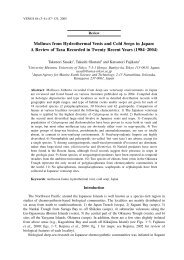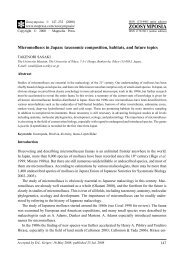Molluscan Research: Techniques for collecting, handling, preparing ...
Molluscan Research: Techniques for collecting, handling, preparing ...
Molluscan Research: Techniques for collecting, handling, preparing ...
Create successful ePaper yourself
Turn your PDF publications into a flip-book with our unique Google optimized e-Paper software.
6<br />
GEIGER ET AL. (2007) MOLLUSCAN RESEARCH, VOL. 27<br />
• Use some kind of rack or stand to keep them available<br />
and ready <strong>for</strong> use.<br />
• Micro-pipette tips used in molecular biology (100–<br />
1000 µl) make excellent tip and needle protectors.<br />
• Preferably use tools made of material that will not<br />
deteriorate quickly in salt water (e.g., stainless steel).<br />
• For microscope work, a com<strong>for</strong>table seat of the correct<br />
height is essential. For fine manipulation, steady your<br />
body by resting your elbows and wrists on the table, use<br />
the back support of your chair, and place your feet<br />
firmly on the ground. Consider breathing rhythm as it<br />
moves the ribcage and arms.<br />
• Keep equipment clean to avoid deterioration and<br />
contamination.<br />
There are a number of suppliers of suitable equipment<br />
who can also offer useful in<strong>for</strong>mation (e.g., http://www.<br />
finescience.com; http://www.mccronemicroscopes.com). We<br />
do not illustrate most of the readily available tools, only<br />
those that are custom made or enlarged views ordinarily not<br />
shown (Fig. 4).<br />
Sieves<br />
For a more efficient examination of samples containing<br />
a large proportion of sediment, the residues should be<br />
divided into size fractions by using graded sieves (e.g., 10, 5,<br />
2.5, 1.0 and 0.4 mm mesh size). If one wants all specimens,<br />
including larval shells, 100 µm mesh is needed, while <strong>for</strong> all<br />
adult species 0.4 mm is suitable. Fractions larger than 5 mm<br />
can be examined with the naked eye. For 5–2 mm a low<br />
power magnifier can be used, although a stereomicroscope is<br />
preferable and gives a better yield as untypical molluscs are<br />
more easily recognised. For smaller fractions a<br />
stereomicroscope is essential. Commercially made sieves<br />
and even shakers <strong>for</strong> banks of sieves are available, or screens<br />
can be constructed from various sizes of wire mesh (Fig.<br />
4H). Sieves can also be made by using short pieces of PVCpipe,<br />
50–250 mm diameter (Fig. 4G). A piece of metal<br />
(preferably stainless steel) mesh slightly wider than the pipe<br />
can be placed on a piece of aluminum foil on a hot plate and<br />
the pipe pushed down on it until the end of the pipe starts to<br />
melt. At that point, put it on a cold surface, still with some<br />
pressure, so the net does not separate from the soft plastic.<br />
Trim off any surplus net and grind the edge to remove any<br />
free wires. Instead of a net, a per<strong>for</strong>ated sheet of stainless<br />
steel can be used. It is a little more difficult to work with but<br />
makes very sturdy sieves that are less readily clogged.<br />
For fieldwork, collapsible nets with a fine mesh<br />
(




